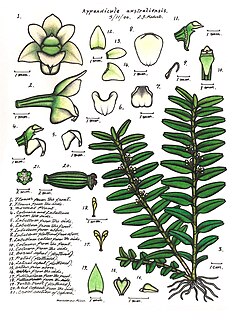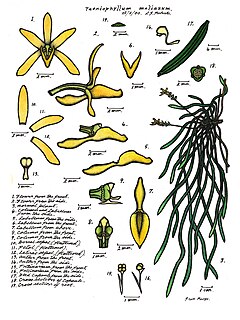
Dendrobium wassellii, commonly known as the furrowed pencil orchid, is a species of orchid endemic to a small area on Cape York Peninsula. It is an epiphytic or lithophytic orchid with branched stems, cylindrical, furrowed leaves and flowering stems with up to sixty crowded white flowers with a yellow labellum.
Bulbophyllum boonjee commonly known as the maroon strand orchid, is a species of epiphytic orchid that is endemic to tropical North Queensland. It has crowded, flattened pseudobulbs, stiff, pale green leaves and up to four small, bell-shaped maroon flowers with darker stripes.
Bulbophyllum bracteatum, commonly known as the blotched pineapple orchid, is a species of epiphytic or sometimes lithophytic orchid that is endemic to eastern Australia. It has crowded pseudobulbs, tough, pale green or yellowish leaves and up to twenty five cream-coloured to yellowish flowers with purplish or reddish blotches. It usually grows in the tops of rainforest trees.

Bulbophyllum elisae, commonly known as the pineapple orchid, is a species of epiphytic or lithophytic orchid that is endemic to eastern Australia. It has crowded, wrinkled, pale green or yellowish clump-forming pseudobulbs, stiff, pale green to yellowish leaves and between three and twelve pale green to dark green flowers with a dark red to purple labellum. It usually grows in the tops of rainforest trees, on cliff faces or boulders.
Mobilabium hamatum, commonly known as hook-leaf, is the only species in the genus Mobilabium from the orchid family, Orchidaceae. It is an epiphytic orchid with between three and twelve stiff, oblong leaves with a hooked tip. There are up to fifteen star-shaped, cream-coloured, pale green or brownish flowers with red or purple markings. The labellum has three lobes with the middle lobe hollow and containing sticky nectar. It mainly grows on rainforest trees at higher altitudes and is found in tropical North Queensland.

Papillilabium beckleri, commonly known as the imp orchid, is the only species in the genus Papillilabium from the orchid family, Orchidaceae. It is a small, epiphytic orchid with many thin roots, between two and six linear leaves and up to eight pale green or brownish flowers. The flowers are fragrant, produce nectar and have a warty labellum. It grows on shrubs and trees in humid places and near streams and is found between south-east Queensland and the Sydney region in New South Wales.
Schistotylus purpuratus, commonly known as purple sprites, is the only species in the genus Schistotylus from the orchid family, Orchidaceae. It is a small epiphytic orchid with up to six crowded, linear leaves and up to ten cup-shaped, pale green flowers with purple marking and a mostly white labellum. It grows in rainforest and swampy heath in eastern Australia.

Podochilus australiensis, commonly known as the native stream orchid, is a species of epiphytic or lithophytic orchid. It has a fern-like appearance with many thin, twisted, glossy green leaves and clusters of up to six dull white or greenish flowers with a green labellum. It grows tropical North Queensland.
Drymoanthus minutus, commonly known as the green midget orchid, is a species of epiphytic or lithophytic orchid that forms small clumps with many thick roots emerging from a thin, erect stem. Between two and five dark green, leathery leaves are arranged along the stem and up to seven minute green to yellowish, star-shaped flowers are arranged on a stiff flowering stem. The sepals and petals are similar to each other and there is a fleshy white, unlobed labellum. This orchid occurs in northern Queensland where it grows in rainforest, usually at higher altitudes.
Taeniophyllum clementsii, commonly known as the fleshy threadfoot, is a species of leafless epiphytic orchid which only grows as single plants. It has short stems and flattened green roots pressed against the tree on which it is growing. Between five and fifty small, pale green, tube-shaped flowers are arranged on a zig-zagged flowering stem. The flowers open one at a time, with the flowering stem increasing in length as each flower opens. This orchid only grows in a small area of tropical North Queensland.

Pomatocalpa macphersonii, commonly known as the blotched bladder orchid, is an epiphytic or lithophytic orchid with thick, cord-like roots, between two and eight dark green, leathery leaves and up to thirty cup-shaped, yellow flowers with red blotches and a white labellum with red blotches. It usually grows on rainforest trees and is found in New Guinea and tropical North Queensland, Australia.

Pomatocalpa marsupiale, commonly known as the branched bladder orchid, is an epiphytic or lithophytic orchid that forms large clumps. It has many thick roots, branched stems, many strap-like, leathery leaves and up to many upward-facing green flowers with a cream-coloured or yellowish labellum. It usually grows on high on rainforest trees and is found between Sulawesi and tropical North Queensland, Australia.

Robiquetia gracilistipes, commonly known as the large pouched orchid, is an epiphytic or lithophytic orchid from the family Orchidaceae that forms large, hanging, straggly clumps. It has long, thick, roots, a single stem, many thick, leathery leaves and up to forty cream-coloured, pale green or brownish flowers with red spots and a three-lobed labellum. It grows on trees and rocks in rainforest, usually in bright light. It is found in Malesia including New Guinea, the Solomon Islands and tropical North Queensland, Australia.

Robiquetia wassellii, commonly known as the green pouched orchid, is an epiphytic or lithophytic orchid from the family Orchidaceae. It has thick roots, a pendulous stem, between three and six crowded, dark green leaves and many crowded dark green flowers with pink to red centres and a white to yellowish labellum. It grows on trees and rocks in rainforest in tropical North Queensland, Australia.
Saccolabiopsis armitii, commonly known as the spotted pitcher orchid, is an epiphytic orchid from the family Orchidaceae. It has a short stem, coarse, wiry roots, between three and six crowded, curved leaves and up to fifty yellowish green flowers with red markings and a white labellum. It usually grows in coastal scrub to rainforest in New Guinea and tropical North Queensland, Australia.
Taeniophyllum confertum, commonly known as the crowded ribbonroot, is a species of leafless epiphytic orchid which only grows as single plants that form small clumps. It has short stems and flattened green roots pressed against the tree on which it is growing. Between five and ten pale green, tube-shaped flowers open one at a time. This orchid only grows in a small area of tropical North Queensland.

Taeniophyllum lobatum, commonly known as the yellow ribbonroot, is a species of leafless epiphytic or lithophytic orchid that forms small clumps. It has short stems, flattened pale to greyish green roots pressed against the substrate on which it is growing and usually two pale to bright yellow flowers. It only occurs in tropical North Queensland.

Taeniophyllum malianum, commonly known as the tangled ribbonroot, is a species of leafless epiphytic or lithophytic orchid that forms tangled clumps. It has flattened green roots with irregular white spots and pressed against the substrate on which it is growing. There are up to fifteen fragrant yellow, short-lived flowers with up to three open at the same time. It only occurs in tropical North Queensland and in New Guinea.
Trachoma papuanum, commonly known as the yellow spectral orchid, is an epiphytic or lithophytic clump-forming orchid with a between three and six thick, fleshy leaves and many dull yellow flowers with a white labellum opening in groups of up to four. This orchid occurs in New Guinea, Queensland and some islands in the South Pacific.
Bryobium irukandjianum, commonly known as the small urchin orchid, is an epiphytic or lithophytic clump-forming orchid that has small, fleshy green pseudobulbs, each with two or three leaves and between seven and twelve small, short-lived, whitish to dull pink flowers. This orchid only occurs in tropical North Queensland.









